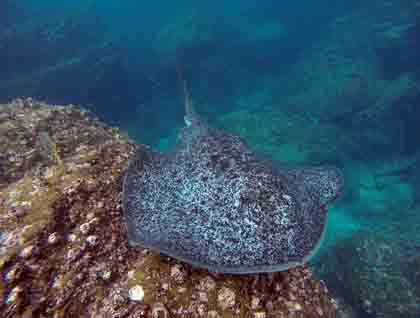Located on the east of Isabela, Santiago Island is unique due to its highlands with fresh water but no inhabitants. There were many attempts to colonize it, but all of them failed. The last one was at James Bay or Puerto Egas, where there was a base for a salt mining operation up until the 1960’s. A small abandoned house and some water tanks remind us of the small group of people that lived here for many years. Much earlier, Santiago Island was well known by ancient visitors such as pirates and buccaneers, and was visited by Charles Darwin in 1835.
After many hours sailing from Isabela, our arrival to Santiago early this morning was upon calm seas and under cloudy skies. We started early with exploration kayaking along the gigantic cliffs near Espumilla beach and its surroundings. We observed blue footed boobies on the rocks, some of them in feeding frenzy, taking advantage of the clear waters which offered great visibility. Paddling north we observed huge collapsed rocks, dropped from the cliffs a few years ago and now home to a small colony of fur sea lions, which swam playfully or rested disinterestedly on the flat rocks. While we kayaked, another group of guests landed on Espumilla beach, one of the largest green sea turtle nesting areas in Galapagos and home of large Palo Santo incense trees, which were green due to the last rainfalls. There were many fresh sea turtle tracks left by those incredible reptiles last night. The National Geographic Islander was repositioned and we arrived shortly at Buccaneers Cove, a popular site for ships during the 18th & 19th centuries. Here our guests enjoyed snorkeling in the clear and warm waters, observing various white tipped reef sharks, sting rays, eagle rays and Indio-pacific bonito tunas zipping into the shallows to feed upon the small anchovies. On the rocks, fur and Galapagos sea lions observed us attentively while in the air, blue footed boobies and pelicans looked for fish. Weighing anchor one last time this morning, we continued towards Puerto Egas a bit farther south on Santiago Island.
After lunch we had a Charles Darwin talk and at four o’clock hikers headed along the black beach and then along the intertidal zone to observe sea shore birds. We found a mix of American oyster catchers, whimbrels, ruddy turnstones, and yellow warblers probing for food along the small ponds and lava rocks that were covered with green algae. We arrived at the “grottos”, a place where lava tubes flooded with turquoise waters are now home to fur sea lions. We observed many of them swimming or sauntering along the rocks and we also saw some yellow crowned night herons resting in the shade of the lava rocks.
As dark rain clouds moved towards us we returned to the National Geographic Islander with grins upon our faces, committing this wonderful day to our memories.







